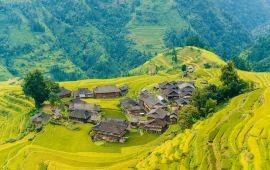A landmark building in Guiyang City, located above the Nanming River. It is built on a large rock in the river, with red beams and green tiles on the building, surrounded by shimmering water. It truly lives up to its name and can be considered as Jiaxiu.
Qingyan Town
The buildings within the ancient city are built along the mountain, with a reasonable layout. The stone carvings and wood carvings are of superb craftsmanship, rich in mythological legends and local characteristics. It is the only 5A-level scenic spot in Guiyang City.
Colorful Guizhou Style
This performance showcases and interprets the diverse ethnic characteristics and customs of Guizhou, featuring Dong songs, ethnic stunts, instrumental performances, and exquisite displays of ethnic costumes. It is a captivating show that makes the audience feel as if they are truly there, and it is a must-see performance for anyone visiting Guizhou.
It is the largest waterfall in Asia and China, rated as 'China's Most Beautiful Place' by Chinese National Geography. It is also one of the most prestigious waterfalls in the world. If you are lucky, you might see a rainbow. Under such strong visual and auditory stimulation, you will definitely feel like cheering. The scenic area, centered around Huangguoshu Waterfall, includes several major scenic spots such as Tianxing Bridge, Doupotang, and Dishuitan.
Tianlong Tunbao Scenic Area
The buildings in this ancient village do not require cement and steel; the stone and wood structures are still very sturdy. Today, the Tunbao people still wear the long sleeves of the Ming Dynasty, perform the military Nuo (Dixi) opera of the Ming Dynasty, and remain immersed in the glory of their ancestors' tradition of 'marking boundaries and running in circles.'
Xijiang Qianhu Miao Village, China
This is the largest Miao village in the country, with about a thousand households, hence the name Qianhu Miao Village. It is formed by the connection of more than a dozen natural villages built along the mountains. The Miao wooden stilt houses on the slopes are stacked layer upon layer in the green mountains, creating a spectacular and beautiful scene. The Baishui River flows through the village, dividing it into two parts, adding more vitality. The Miao costumes, Miao songs and dances, and Miao customs are all very attractive. It is currently the second largest tourist attraction in Guizhou, second only to the Huangguoshu Waterfall.
Belonging to Leishan County along with Xijiang Qianhu Miao Village, the Miao people's clothing in the village is characterized by long skirts, hence also known as 'Long Skirt Miao'. The commercial atmosphere is not strong, making it a relatively small Miao village with fewer tourists. In Langde, you will discover that life can be so simple.
Zhenyuan Ancient Town
One of the ten most beautiful ancient towns in China, it boasts majestic mountains and beautiful waters. Shibing Mountain stands like a proud lion with its head held high, while the Wuyang River winds through the town like a jade belt in an 'S' shape. The town and water blend seamlessly, creating picturesque reflections. This unique Taiji diagram, 'Nine mountains embracing water, one river dividing two towns,' has earned it the title of China's Mountain Cliff Culture Museum. The ancient streets and alleys within the town are winding and secluded, with stone bridges and city walls arranged in an orderly manner, exuding a rich charm.
Libo Scenic Area
The unique landform landscape, the magical and dense original vegetation, the rare biological species, and the colorful real mountains and waters are the four major features of the Libo Scenic Area. Among them, the 'Xiaoqikong Scenic Area' is the most famous, integrating mountains, water, forests, caves, lakes, and waterfalls. It is beautiful and quiet, coupled with the rich Tujia and Yao ethnic customs, making it the third most iconic tourist attraction in Guizhou. The adjacent 'Daqikong Scenic Area' combines karst landforms and hydrological landscapes, with steep and majestic scenery, giving a sense of thrill and mystery, and is also worth a visit.
A newly listed World Natural Heritage site in China, a famous Maitreya Bodhisattva sanctuary in the country, and the fifth major Buddhist mountain in China, known for its 'Brahma Pure Land'. It holds a significant place in Buddhist history. Fanjing Mountain has well-preserved primitive ecology, home to many rare species, and lacks man-made landscapes. The 'Mushroom Stone' main peak stands tall among the mountains, with a history of one billion years, making it a popular spot for photography.























